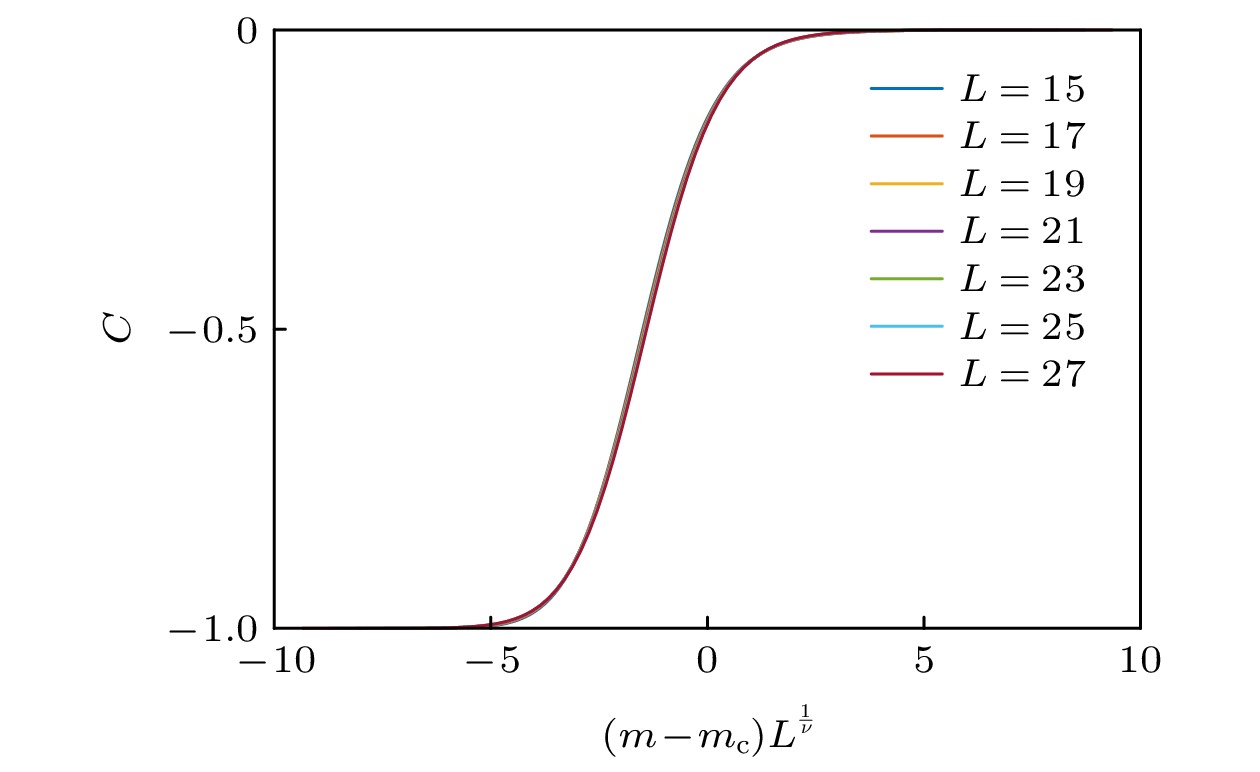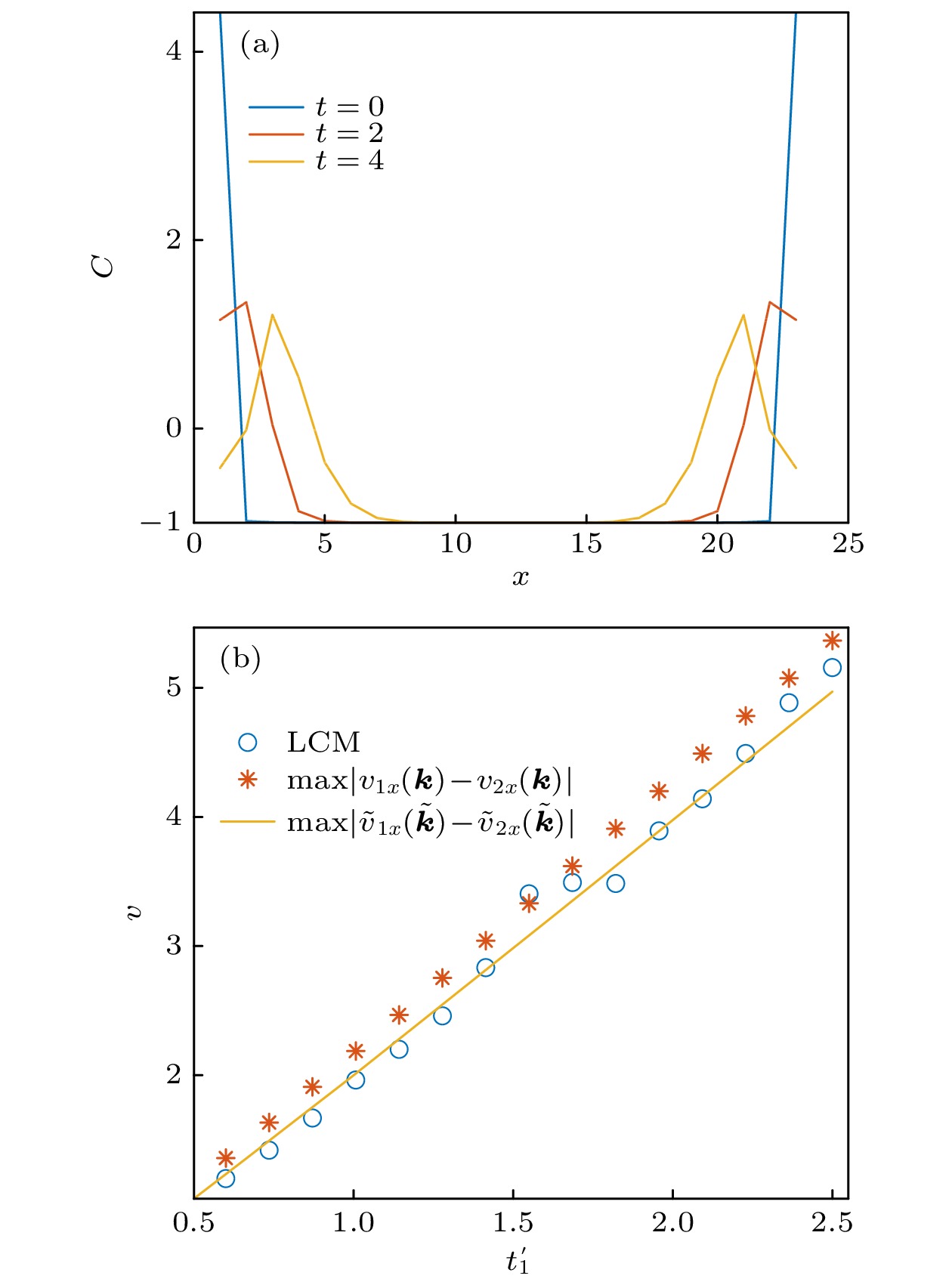-
非厄米拓扑系统的拓扑不变量可以由定义在双正交基下的局域拓扑指标刻画. 不同于厄米体系, 非厄米局域拓扑指标在动力学过程中的传播和演化目前还未见文献讨论. 本文研究非厄米拓扑体系局域拓扑指标的动力学特性, 重点关注淬火过程中, 局域拓扑指标由边界向体内的传播. 结果表明, 当淬火前后的体系拓扑性质不同时, 系统中存在局域拓扑指标的流动, 其流速与体系群速度相关, 但具体形式与相应厄米体系不同. 以3个具体模型为例, 通过数值计算说明了这一结论. 其中, 对于特定具有非厄米趋肤效应的模型, 可以发现局域拓扑指标的流速上限与广义布里渊区中的群速度直接相关. 但这一关系在其他非厄米模型中则需要修正, 其更普适的形式有待进一步研究. 本文的结果揭示了非厄米体系中局域拓扑指标传播的复杂性, 是进一步理解非厄米局域拓扑指标动力学行为的基础.
Topological invariants of non-Hermitian topological systems can be captured by local topological markers defined on the biorthogonal basis. However, unlike the scenario of Hermitian systems, the dynamics of non-Hermitian local topological marker has not yet received much attention so far. Here in this work, we study the dynamic features of local topological markers in non-Hermitian topological systems. In particular, we focus on the propagation of non-Hermitian topological markers in quench dynamics. We find that for the dynamics with topologically distinct pre- and post-quench Hamiltonians, a flow of local topological markers emerges in the bulk, with its propagation speed related to the maximum group velocity. Taking three different non-Hermitian topological models for example, we numerically calculate the propagation speed, and demonstrate that a simple universal relation between the propagation speed and group velocity does not exist, which is unlike the scenarios in previously studied Hermitian systems. Our results reveal the complexity of the local-topological-marker dynamics in non-Hermitian settings, and would stimulate further study on the matter. -
Keywords:
- non-Hermitian topology /
- quench dynamics /
- open systems
[1] Ashida Y, Gong Z, Ueda M 2020 Adv. Phys. 69 249
 Google Scholar
Google Scholar
[2] Kawabata K, Shiozaki k, Ueda M, Sato M 2019 Phys. Rev. X 9 041015
 Google Scholar
Google Scholar
[3] Zhou H, Lee J Y 2019 Phys. Rev. B 99 235112
 Google Scholar
Google Scholar
[4] Bender C M 2007 Rep. Prog. Phys. 70 947
 Google Scholar
Google Scholar
[5] Konotop V V, Yang J, Zezyulin D A 2016 Rev. Mod. Phys. 88 035002
 Google Scholar
Google Scholar
[6] El-Ganainy R, Makris K G, Khajavikhan M, Musslimani Z H, Rotter S, Christodoulides D N 2017 Nat. Phys. 14 11
 Google Scholar
Google Scholar
[7] Dalibard J, Castin Y, Mölmer K 1992 Phys. Rev. Lett. 68 580
 Google Scholar
Google Scholar
[8] Carmichael H J 1993 Phys. Rev. Lett. 70 2273
 Google Scholar
Google Scholar
[9] Yao S Y, Wang Z 2018 Phy. Rev. Lett. 121 086803
 Google Scholar
Google Scholar
[10] Yao S Y, Song F, Wang Z 2018 Phys. Rev. Lett. 121 136802
 Google Scholar
Google Scholar
[11] Lee C H, Thomale R 2019 Phy. Rev. B 99 201103
 Google Scholar
Google Scholar
[12] McDonald A, Pereg-Barnea T, Clerk A A, 2018 Phys. Rev. X 8 041031
 Google Scholar
Google Scholar
[13] Kunst F K, Edvardsson E, Budich J C, Bergholtz E J 2018 Phy. Rev. Lett. 121 026808
 Google Scholar
Google Scholar
[14] Yokomizo K, Murakami S 2019 Phys. Rev. Lett. 123 066404
 Google Scholar
Google Scholar
[15] Zhang K, Yang Z, Fang C 2020 Phy. Rev. Lett. 125 126402
 Google Scholar
Google Scholar
[16] Okuma N, Kawabata K, Shiozaki K, Sato M 2020 Phys. Rev. Lett. 124 086801
 Google Scholar
Google Scholar
[17] Lee T E 2016 Phy. Rev. Lett. 16 133903
 Google Scholar
Google Scholar
[18] Zhang X Z, Gong J B, 2020 Phy. Rev. B 101 045415
 Google Scholar
Google Scholar
[19] Zeng Q B, Yang Y B, Xu Y 2020 Phy. Rev. B 101 020201
 Google Scholar
Google Scholar
[20] Wang X R, Guo C X, Kou S P 2020 Phy. Rev. B 101 121116
 Google Scholar
Google Scholar
[21] Li T Y, Zhang Y S, Yi W 2021 Chin. Phys. Lett. 38 030301
 Google Scholar
Google Scholar
[22] Helbig T, Hofmann T, Imhof S, Abdelghany M, Kiessling T, Molenkamp L W, Lee C H, Szameit A, Greiter M, Thomale R 2020 Nat. Phys. 16 747
 Google Scholar
Google Scholar
[23] Xiao L, Deng T S, Wang K K, Zhu G, Wang Z, Yi W, Xue P 2020 Nat. Phys. 16 761
 Google Scholar
Google Scholar
[24] Ghatak A, Brandenbourger M, van Wezel J, Coulais C 2020 Proc. Natl. Acad. Sci. U.S.A. 117 29561
 Google Scholar
Google Scholar
[25] Weidemann S, Kremer M, Helbig T, Hofmann T, Stegmaier A, Greiter M, Thomale R, Szameit A 2020 Science 368 311
 Google Scholar
Google Scholar
[26] Longhi S 2019 Phys. Rev. Res. 1 023013
 Google Scholar
Google Scholar
[27] Longhi S 2019 Opt. Lett. 44 5804
 Google Scholar
Google Scholar
[28] Xiao L, Deng T S, Wang K K, Wang Z, Yi W, Xue P 2021 Phys. Rev. Lett. 126 230402
 Google Scholar
Google Scholar
[29] Li T Y, Sun J Z, Zhang Y S, Yi W 2021 Phys. Rev. Res. 3 023022
 Google Scholar
Google Scholar
[30] Wang K, Li T, Xiao L, Han Y, Yi W, Xue P 2021 arXiv: 2107.14741
[31] Luo X W, Zhang C W 2019 arXiv: 1912.10652
[32] Song F, Yao S, Wang Z 2019 Phys. Rev. Lett. 123 246801
 Google Scholar
Google Scholar
[33] Bianco R, Resta R 2011 Phys. Rev. B 84 241106
 Google Scholar
Google Scholar
[34] Caio M D, Mller G, Cooper N R, Bhaseen M J 2019 Nat. Phys. 15 257
 Google Scholar
Google Scholar
[35] Privitera L and Santoro G E 2016 Phy. Rev. B 93 241406
 Google Scholar
Google Scholar
[36] Pozo O, Repellin C, Grushin A G 2019 Phys. Rev. Lett. 123 247401
 Google Scholar
Google Scholar
[37] Qi X L, Wu Y S, Zhang S C 2006 Phys. Rev. B 74 085308
 Google Scholar
Google Scholar
[38] Qi X L, Zhang S C 2011 Rev. Mod. Phys. 83 1057
 Google Scholar
Google Scholar
-
图 1 非厄米局域拓扑指标的标度行为. 系统中心的非厄米局域拓扑指标随着
$m$ 的变化遵循$(m-m_{\rm c})L^{\tfrac{1}{\nu}}$ 的标度行为. 在$L$ 分别取$15, 17, 19, 21, 23, 25, 27$ 等值时(对应于图中不同颜色的曲线), 所有曲线经变换后遵循同一函数形式, 经拟合得到$\nu\approx 1.1259$ . 在本文的数值计算中, 取$t_1=1$ ,$\gamma_x=\gamma_y=0.3$ Fig. 1. Scaling behavior of the non-Hermitian local topological marker near the topological phase transition. The numerically calculated local topological markers for different system sizes (
$L=15, 17, 19, 21, 23, 25, 27$ ) collapse to the same curve, with the functional form$(m-m_{\rm c})L^{\tfrac{1}{\nu}}$ and$\nu\approx 1.12(6)$ . For all calculations, we take$t_1=1$ ,$\gamma_x= $ $ \gamma_y=0.3$ 图 2 非厄米局域拓扑指标的传播速度 (a) 淬火过程中系统中心格点处的非厄米局域拓扑指标的时间演化. 系统尺寸为
$L=23$ , 取开边界. 初始时${\boldsymbol{H}}\left(t_1=1,\; m=1\right)$ 处于拓扑非平庸相, 淬火后${\boldsymbol{H}}\left(t^{\prime}_1=1,\; m^{\prime}=6\right)$ 处于拓扑平庸相, 淬火前后$\gamma_x=\gamma_y=0.3$ . 这里只考虑$x$ 方向的动力学演化,$y$ 方向的演化有类似性质. (b) 非厄米局域拓扑指标的传播速度随末态哈密顿量参数$t^{\prime}_1$ 的变化. 淬火参数与图(a)相同. 分别数值模拟了体系大小为$L=11, 15, 19, 23, 27$ 时的淬火过程, 并通过线性拟合$t^\ast$ 与$L$ 的关系, 数值得到了局域拓扑指标的传播速度Fig. 2. Dynamics of the non-Hermitian local topological marker. (a) Spatial distribution (along the
$x$ -direction) of the non-Hermitian local topological marker at different times of the quench dynamics. The parameters are:$L=23$ ,${\boldsymbol{H}}_{\rm i}(t_1=1, \;m=1)$ ,${\boldsymbol{H}}_{\rm f}(t'_1=1, \;m'=6)$ ,$\gamma_x=\gamma_y=0.3$ . (b) Propagation speed of the local topological marker as a function of$t'_1$ . Other parameters are the same as those in panel (a).图 3 模型(5)的非厄米局域拓扑指标的传播速度随
$t^{\prime}_1$ 的变化. 初始时,$t_x=t_y=1, m=1$ ; 淬火后,$t^{\prime}_x=t^{\prime}_y=t^{\prime}_1, $ $ m^{\prime}=6$ . 淬火前后$\gamma_x= \gamma_y=\gamma=0.35$ Fig. 3. Propagation speed of the non-Hermitian local topological marker for Hamiltonian (5). We fix
$\gamma_x=\gamma_y=\gamma=0.35$ , and the pre- and post-quench parameters are$t_x=t_y=1, $ $ \; m=1$ and$t^{\prime}_x=t^{\prime}_y=t^{\prime}_1, \; m^{\prime}=6$ , respectively.图 4 模型(8)的非厄米局域拓扑指标的传播速度随
$t^{\prime}_1$ 的变化. 初始时,$t_x=t_y=1, m=1$ ; 淬火后,$t^{\prime}_x=t^{\prime}_y=t^{\prime}_1, $ $ m^{\prime}=6$ . 淬火前后$\gamma=0.3$ Fig. 4. Propagation speed of the non-Hermitian local topological marker for Hamiltonian (8). We fix
$\gamma=0.3$ , and the pre- and post-quench parameters are$t_x=t_y=1, m=1$ and$t^{\prime}_x=t^{\prime}_y=t^{\prime}_1, m^{\prime}=6$ , respectively. -
[1] Ashida Y, Gong Z, Ueda M 2020 Adv. Phys. 69 249
 Google Scholar
Google Scholar
[2] Kawabata K, Shiozaki k, Ueda M, Sato M 2019 Phys. Rev. X 9 041015
 Google Scholar
Google Scholar
[3] Zhou H, Lee J Y 2019 Phys. Rev. B 99 235112
 Google Scholar
Google Scholar
[4] Bender C M 2007 Rep. Prog. Phys. 70 947
 Google Scholar
Google Scholar
[5] Konotop V V, Yang J, Zezyulin D A 2016 Rev. Mod. Phys. 88 035002
 Google Scholar
Google Scholar
[6] El-Ganainy R, Makris K G, Khajavikhan M, Musslimani Z H, Rotter S, Christodoulides D N 2017 Nat. Phys. 14 11
 Google Scholar
Google Scholar
[7] Dalibard J, Castin Y, Mölmer K 1992 Phys. Rev. Lett. 68 580
 Google Scholar
Google Scholar
[8] Carmichael H J 1993 Phys. Rev. Lett. 70 2273
 Google Scholar
Google Scholar
[9] Yao S Y, Wang Z 2018 Phy. Rev. Lett. 121 086803
 Google Scholar
Google Scholar
[10] Yao S Y, Song F, Wang Z 2018 Phys. Rev. Lett. 121 136802
 Google Scholar
Google Scholar
[11] Lee C H, Thomale R 2019 Phy. Rev. B 99 201103
 Google Scholar
Google Scholar
[12] McDonald A, Pereg-Barnea T, Clerk A A, 2018 Phys. Rev. X 8 041031
 Google Scholar
Google Scholar
[13] Kunst F K, Edvardsson E, Budich J C, Bergholtz E J 2018 Phy. Rev. Lett. 121 026808
 Google Scholar
Google Scholar
[14] Yokomizo K, Murakami S 2019 Phys. Rev. Lett. 123 066404
 Google Scholar
Google Scholar
[15] Zhang K, Yang Z, Fang C 2020 Phy. Rev. Lett. 125 126402
 Google Scholar
Google Scholar
[16] Okuma N, Kawabata K, Shiozaki K, Sato M 2020 Phys. Rev. Lett. 124 086801
 Google Scholar
Google Scholar
[17] Lee T E 2016 Phy. Rev. Lett. 16 133903
 Google Scholar
Google Scholar
[18] Zhang X Z, Gong J B, 2020 Phy. Rev. B 101 045415
 Google Scholar
Google Scholar
[19] Zeng Q B, Yang Y B, Xu Y 2020 Phy. Rev. B 101 020201
 Google Scholar
Google Scholar
[20] Wang X R, Guo C X, Kou S P 2020 Phy. Rev. B 101 121116
 Google Scholar
Google Scholar
[21] Li T Y, Zhang Y S, Yi W 2021 Chin. Phys. Lett. 38 030301
 Google Scholar
Google Scholar
[22] Helbig T, Hofmann T, Imhof S, Abdelghany M, Kiessling T, Molenkamp L W, Lee C H, Szameit A, Greiter M, Thomale R 2020 Nat. Phys. 16 747
 Google Scholar
Google Scholar
[23] Xiao L, Deng T S, Wang K K, Zhu G, Wang Z, Yi W, Xue P 2020 Nat. Phys. 16 761
 Google Scholar
Google Scholar
[24] Ghatak A, Brandenbourger M, van Wezel J, Coulais C 2020 Proc. Natl. Acad. Sci. U.S.A. 117 29561
 Google Scholar
Google Scholar
[25] Weidemann S, Kremer M, Helbig T, Hofmann T, Stegmaier A, Greiter M, Thomale R, Szameit A 2020 Science 368 311
 Google Scholar
Google Scholar
[26] Longhi S 2019 Phys. Rev. Res. 1 023013
 Google Scholar
Google Scholar
[27] Longhi S 2019 Opt. Lett. 44 5804
 Google Scholar
Google Scholar
[28] Xiao L, Deng T S, Wang K K, Wang Z, Yi W, Xue P 2021 Phys. Rev. Lett. 126 230402
 Google Scholar
Google Scholar
[29] Li T Y, Sun J Z, Zhang Y S, Yi W 2021 Phys. Rev. Res. 3 023022
 Google Scholar
Google Scholar
[30] Wang K, Li T, Xiao L, Han Y, Yi W, Xue P 2021 arXiv: 2107.14741
[31] Luo X W, Zhang C W 2019 arXiv: 1912.10652
[32] Song F, Yao S, Wang Z 2019 Phys. Rev. Lett. 123 246801
 Google Scholar
Google Scholar
[33] Bianco R, Resta R 2011 Phys. Rev. B 84 241106
 Google Scholar
Google Scholar
[34] Caio M D, Mller G, Cooper N R, Bhaseen M J 2019 Nat. Phys. 15 257
 Google Scholar
Google Scholar
[35] Privitera L and Santoro G E 2016 Phy. Rev. B 93 241406
 Google Scholar
Google Scholar
[36] Pozo O, Repellin C, Grushin A G 2019 Phys. Rev. Lett. 123 247401
 Google Scholar
Google Scholar
[37] Qi X L, Wu Y S, Zhang S C 2006 Phys. Rev. B 74 085308
 Google Scholar
Google Scholar
[38] Qi X L, Zhang S C 2011 Rev. Mod. Phys. 83 1057
 Google Scholar
Google Scholar
计量
- 文章访问数: 7835
- PDF下载量: 452
- 被引次数: 0



























 下载:
下载:





































